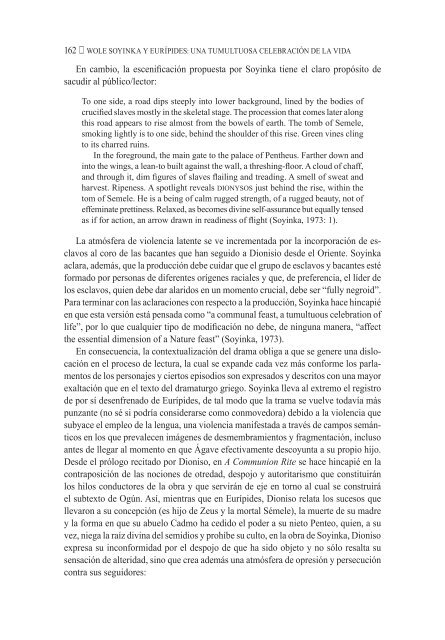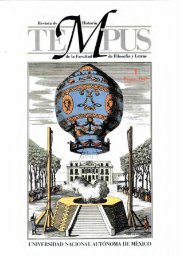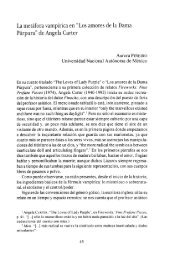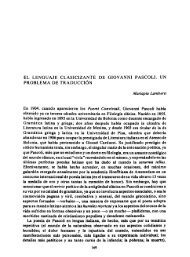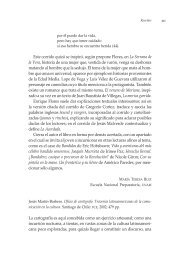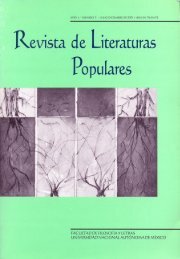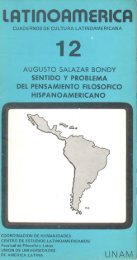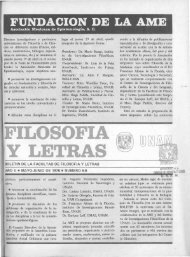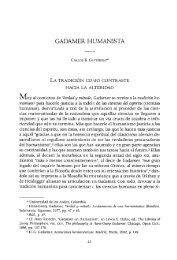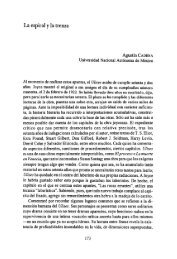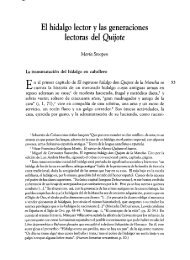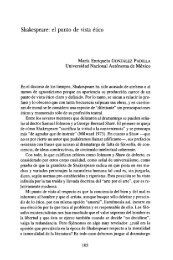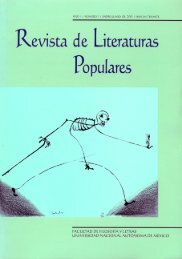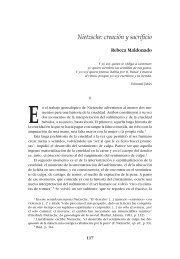Untitled - Repositorio de la Facultad de Filosofía y Letras. UNAM ...
Untitled - Repositorio de la Facultad de Filosofía y Letras. UNAM ...
Untitled - Repositorio de la Facultad de Filosofía y Letras. UNAM ...
Create successful ePaper yourself
Turn your PDF publications into a flip-book with our unique Google optimized e-Paper software.
162 WOLE SOYINkA Y EuríPIDES: uNA TuMuLTuOSA CELEbrACIóN DE LA vIDA<br />
En cambio, <strong>la</strong> escenificación propuesta por Soyinka tiene el c<strong>la</strong>ro propósito <strong>de</strong><br />
sacudir al público/lector:<br />
To one si<strong>de</strong>, a road dips steeply into lower background, lined by the bodies of<br />
crucified s<strong>la</strong>ves mostly in the skeletal stage. The procession that comes <strong>la</strong>ter along<br />
this road appears to rise almost from the bowels of earth. The tomb of Semele,<br />
smoking lightly is to one si<strong>de</strong>, behind the shoul<strong>de</strong>r of this rise. Green vines cling<br />
to its charred ruins.<br />
In the foreground, the main gate to the pa<strong>la</strong>ce of Pentheus. farther down and<br />
into the wings, a lean-to built against the wall, a threshing-floor. A cloud of chaff,<br />
and through it, dim figures of s<strong>la</strong>ves f<strong>la</strong>iling and treading. A smell of sweat and<br />
harvest. Ripeness. A spotlight reveals dionysos just behind the rise, within the<br />
tom of Semele. He is a being of calm rugged strength, of a rugged beauty, not of<br />
effeminate prettiness. re<strong>la</strong>xed, as becomes divine self-assurance but equally tensed<br />
as if for action, an arrow drawn in readiness of flight (Soyinka, 1973: 1).<br />
La atmósfera <strong>de</strong> violencia <strong>la</strong>tente se ve incrementada por <strong>la</strong> incorporación <strong>de</strong> esc<strong>la</strong>vos<br />
al coro <strong>de</strong> <strong>la</strong>s bacantes que han seguido a Dionisio <strong>de</strong>s<strong>de</strong> el Oriente. Soyinka<br />
ac<strong>la</strong>ra, a<strong>de</strong>más, que <strong>la</strong> producción <strong>de</strong>be cuidar que el grupo <strong>de</strong> esc<strong>la</strong>vos y bacantes esté<br />
formado por personas <strong>de</strong> diferentes orígenes raciales y que, <strong>de</strong> preferencia, el lí<strong>de</strong>r <strong>de</strong><br />
los esc<strong>la</strong>vos, quien <strong>de</strong>be dar a<strong>la</strong>ridos en un momento crucial, <strong>de</strong>be ser “fully negroid”.<br />
Para terminar con <strong>la</strong>s ac<strong>la</strong>raciones con respecto a <strong>la</strong> producción, Soyinka hace hincapié<br />
en que esta versión está pensada como “a communal feast, a tumultuous celebration of<br />
life”, por lo que cualquier tipo <strong>de</strong> modificación no <strong>de</strong>be, <strong>de</strong> ninguna manera, “affect<br />
the essential dimension of a Nature feast” (Soyinka, 1973).<br />
En consecuencia, <strong>la</strong> contextualización <strong>de</strong>l drama obliga a que se genere una dislocación<br />
en el proceso <strong>de</strong> lectura, <strong>la</strong> cual se expan<strong>de</strong> cada vez más conforme los par<strong>la</strong>mentos<br />
<strong>de</strong> los personajes y ciertos episodios son expresados y <strong>de</strong>scritos con una mayor<br />
exaltación que en el texto <strong>de</strong>l dramaturgo griego. Soyinka lleva al extremo el registro<br />
<strong>de</strong> por sí <strong>de</strong>senfrenado <strong>de</strong> Eurípi<strong>de</strong>s, <strong>de</strong> tal modo que <strong>la</strong> trama se vuelve todavía más<br />
punzante (no sé si podría consi<strong>de</strong>rarse como conmovedora) <strong>de</strong>bido a <strong>la</strong> violencia que<br />
subyace el empleo <strong>de</strong> <strong>la</strong> lengua, una violencia manifestada a través <strong>de</strong> campos semánticos<br />
en los que prevalecen imágenes <strong>de</strong> <strong>de</strong>smembramientos y fragmentación, incluso<br />
antes <strong>de</strong> llegar al momento en que ágave efectivamente <strong>de</strong>scoyunta a su propio hijo.<br />
Des<strong>de</strong> el prólogo recitado por Dioniso, en A Communion Rite se hace hincapié en <strong>la</strong><br />
contraposición <strong>de</strong> <strong>la</strong>s nociones <strong>de</strong> otredad, <strong>de</strong>spojo y autoritarismo que constituirán<br />
los hilos conductores <strong>de</strong> <strong>la</strong> obra y que servirán <strong>de</strong> eje en torno al cual se construirá<br />
el subtexto <strong>de</strong> Ogún. Así, mientras que en Eurípi<strong>de</strong>s, Dioniso re<strong>la</strong>ta los sucesos que<br />
llevaron a su concepción (es hijo <strong>de</strong> Zeus y <strong>la</strong> mortal Sémele), <strong>la</strong> muerte <strong>de</strong> su madre<br />
y <strong>la</strong> forma en que su abuelo Cadmo ha cedido el po<strong>de</strong>r a su nieto Penteo, quien, a su<br />
vez, niega <strong>la</strong> raíz divina <strong>de</strong>l semidios y prohíbe su culto, en <strong>la</strong> obra <strong>de</strong> Soyinka, Dioniso<br />
expresa su inconformidad por el <strong>de</strong>spojo <strong>de</strong> que ha sido objeto y no sólo resalta su<br />
sensación <strong>de</strong> alteridad, sino que crea a<strong>de</strong>más una atmósfera <strong>de</strong> opresión y persecución<br />
contra sus seguidores:


